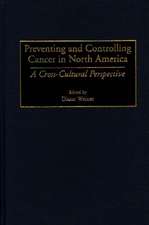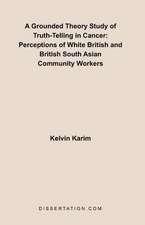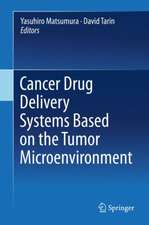Understanding Cancer: The Molecular Mechanisms, Biology, Pathology and Clinical Implications of Malignant Neoplasia
Autor David Tarinen Limba Engleză Hardback – 3 feb 2023
Mechanisms of action of carcinogenic agents, initiation, progression, metastasis, inappropriate gene expression, dormancy, latency, regression, and reasons for susceptibility and/or resistance to cancer are all considered. Also discussed are criteria for pathological diagnosis, advances in treatment, implications for public health, and pitfalls in diagnosis and interpretation of experimental results.
- The book describes operational mechanisms of cancer at the levels of whole individual, organ, tissue, cell, molecular, and even atomic (quantum) scales of structural and physiological order.
- Evidence is assembled from all these levels of organization to show that cancer is a dynamically changing disorder and that it is an inherent and perpetual risk of multicellular composition. This provides pragmatic new biological and clinical perspectives on malignant neoplasia. The biological insight is that it is a consequence of progressing miscommunication within a cellular society.
- The clinical perspective is realistic but optimistic in reasoning that, although cancer can never be completely eradicated from human life, because it is a disorder of our intrinsic biological constitution, it can be controlled and ameliorated and even cured in a proportion of individuals.
- The text is profusely illustrated with over 300 macroscopic and microscopic pictures. It will stimulate curiosity and interest specialists, as well as beginners, in many scientific disciplines and provides copious references to the medical and scientific literature supporting its conclusions.
- Readers from fields as diverse as medicine, pathology, veterinary sciences, cell biology, molecular biology, developmental biology, and epidemiology will find the information the book contains thought-provoking, interesting, and useful. Additionally, specialists in occupational and environmental health and legal experts focusing on exposure to carcinogenic materials and pollution will find the contents valuable and informative.
| Toate formatele și edițiile | Preț | Express |
|---|---|---|
| Paperback (1) | 1617.08 lei 6-8 săpt. | |
| Springer International Publishing – 3 feb 2024 | 1617.08 lei 6-8 săpt. | |
| Hardback (1) | 1480.47 lei 38-44 zile | |
| Springer International Publishing – 3 feb 2023 | 1480.47 lei 38-44 zile |
Preț: 1480.47 lei
Preț vechi: 1558.39 lei
-5% Nou
Puncte Express: 2221
Preț estimativ în valută:
283.29€ • 308.68$ • 238.71£
283.29€ • 308.68$ • 238.71£
Carte tipărită la comandă
Livrare economică 19-25 aprilie
Preluare comenzi: 021 569.72.76
Specificații
ISBN-13: 9783030973926
ISBN-10: 3030973921
Pagini: 325
Ilustrații: XXV, 325 p. 139 illus., 116 illus. in color.
Dimensiuni: 210 x 279 mm
Greutate: 1.22 kg
Ediția:1st ed. 2023
Editura: Springer International Publishing
Colecția Springer
Locul publicării:Cham, Switzerland
ISBN-10: 3030973921
Pagini: 325
Ilustrații: XXV, 325 p. 139 illus., 116 illus. in color.
Dimensiuni: 210 x 279 mm
Greutate: 1.22 kg
Ediția:1st ed. 2023
Editura: Springer International Publishing
Colecția Springer
Locul publicării:Cham, Switzerland
Cuprins
Notă biografică
David Tarin is an internationally recognised physician, pathologist and scientist who has specialised in clinical diagnostic pathology and research on carcinogenesis, cancer metastasis and developmental biology. Over 6 decades he has held positions as Director of the Comprehensive Cancer Center at the University of California, San Diego; Professor of Pathology at Oxford University School of Medicine, and Professor of Pathology at the Royal Postgraduate School of Medicine, London, as well as faculty positions at other Universities. He has also worked briefly at the Department of Pathology and the Department of Zoology in the University of Helsinki, Finland and at the Austrian Cancer Institute in Vienna, Austria. In addition to the current volume, he has published 2 other books on cancer, cited below* and multiple research and clinical articles and book chapters. He has acted as an advisor to the US National Cancer Institute and to the Cancer Research Campaign of the United Kingdom. He is also widely regarded as an expert medical witness in occupational and environmental carcinogenesis and in pathological diagnosis, based on his research and clinical experience and has testified in many jurisdictions internationally.
- Tissue Interactions in Carcinogenesis; Academic Press London 1972
- Drug Delivery Systems Based upon the Tumour Microenvironment; Springer Japan 2020
Textul de pe ultima copertă
This book provides a unique, wide-ranging description of the phenomenon of cancer and its pathological effects in diverse species including humans, domesticated and wild animals, invertebrates, and plants. The broad scope of information presented is used to construct radical new insights into biological self-regulation and explain their relevance to its disruption by cancerous growth and spread within the human body.
Mechanisms of action of carcinogenic agents, initiation, progression, metastasis, inappropriate gene expression, dormancy, latency, regression, and reasons for susceptibility and/or resistance to cancer are all considered. Also discussed are criteria for pathological diagnosis, advances in treatment, implications for public health, and pitfalls in diagnosis and interpretation of experimental results.
Mechanisms of action of carcinogenic agents, initiation, progression, metastasis, inappropriate gene expression, dormancy, latency, regression, and reasons for susceptibility and/or resistance to cancer are all considered. Also discussed are criteria for pathological diagnosis, advances in treatment, implications for public health, and pitfalls in diagnosis and interpretation of experimental results.
- The book describes operational mechanisms of cancer at the levels of whole individual, organ, tissue, cell, molecular, and even atomic (quantum) scales of structural and physiological order.
- Evidence is assembled from all these levels of organization to show that cancer is a dynamically changing disorder and that it is an inherent and perpetual risk of multicellular composition. This provides pragmatic new biological and clinical perspectives on malignant neoplasia. The biological insight is that it is a consequence of progressing miscommunication within a cellular society.
- The clinical perspective is realistic but optimistic in reasoning that, although cancer can never be completely eradicated from human life, because it is a disorder of our intrinsic biological constitution, it can be controlled and ameliorated and even cured in a proportion of individuals.
- The text is profusely illustrated with over 300 macroscopic and microscopic pictures. It will stimulate curiosity and interest specialists, as well as beginners, in many scientific disciplines and provides copious references to the medical and scientific literature supporting its conclusions.
- Readers from fields as diverse as medicine, pathology, veterinary sciences, cell biology, molecular biology, developmental biology, and epidemiology will find the information the book contains thought-provoking, interesting, and useful. Additionally, specialists in occupational and environmental health and legal experts focusing on exposure to carcinogenic materials and pollution will find the contents valuable and informative.
Caracteristici
Integrates evidence from molecular biology, embryology, cell biology, pathology, and clinical oncology
Reviews the history of understanding of cancer formation and metastasis and their clinical effects and treatment
Is narrative designed to be interesting and to stimulate curiosity in a wide audience from beginners to experts
Reviews the history of understanding of cancer formation and metastasis and their clinical effects and treatment
Is narrative designed to be interesting and to stimulate curiosity in a wide audience from beginners to experts






















